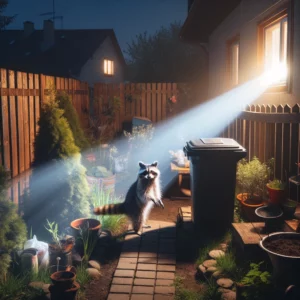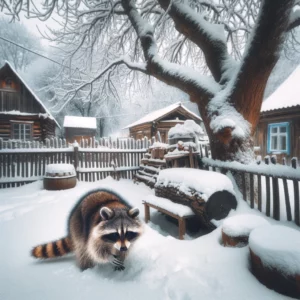
Raccoons are fascinating creatures that are commonly found in the Dallas-Fort Worth area. In this comprehensive guide, we will explore various aspects of raccoons, including their behavior, physical characteristics, potential dangers, causes of infestation, and effective methods for removal. Additionally, we will discuss how to prevent future raccoon encounters and keep your property safe.
Raccoons are known for their mischievous nature and inquisitive behavior. They are highly adaptable and can thrive in various environments, including urban areas. Understanding their behavior and habits is essential for dealing with raccoon-related issues.
Raccoons are primarily nocturnal creatures, meaning they are most active during the night. They have a keen sense of smell, allowing them to locate potential food sources from a distance. Raccoons are omnivorous, feeding on both plant matter and small animals. They are also skilled climbers and swimmers, making them versatile in their search for food and shelter.

Raccoons are known for their dexterous paws, which they use to manipulate objects and open containers. This ability often leads to raccoons causing havoc in trash cans and dumpsters in search of food.
When it comes to their social behavior, raccoons are not solitary animals. They often live in small family groups, consisting of a female and her offspring. These groups, known as nursery colonies, provide protection and support for the young raccoons as they learn essential survival skills. Raccoons are also known to have a wide range of vocalizations, including growls, hisses, and chattering sounds, which they use to communicate with each other.
In terms of their habits, raccoons are known for their curious nature. They are constantly exploring their surroundings and investigating new objects or areas. This curiosity often leads them into trouble, as they may venture into human dwellings or get trapped in confined spaces. Raccoons are also known to be highly adaptable when it comes to their diet. While they primarily feed on fruits, nuts, and insects, they are not picky eaters and will scavenge for food in garbage cans or even hunt small animals if necessary.
Raccoons are recognizable by their distinct physical features. They have a stocky build, with a bushy tail that can be up to half the length of their body. Their fur is grayish-brown in color, with a band of black fur around their eyes that resembles a mask. This distinctive mask-like marking gives raccoons their iconic appearance.
Adult raccoons can weigh anywhere from 10 to 30 pounds, with males typically being larger than females. Their average lifespan in the wild is around 2-3 years, although in captivity they can live up to 20 years.
One interesting physical characteristic of raccoons is their highly sensitive front paws. These paws have a remarkable sense of touch, allowing raccoons to feel their way around objects and detect subtle changes in their environment. This sensitivity, combined with their dexterity, enables raccoons to manipulate objects with great precision, such as opening latches or unscrewing lids.
Raccoons also have a unique adaptation when it comes to their teeth. They possess sharp incisors, which they use for biting and tearing food, as well as strong molars for grinding. This dental structure allows raccoons to consume a wide variety of food, from hard-shelled nuts to soft fruits.
Another notable physical feature of raccoons is their ability to adapt to different climates. Their thick fur provides insulation during colder months, while their sweat glands help regulate body temperature during warmer periods. This adaptability allows raccoons to survive in a wide range of environments, from forests and wetlands to suburban neighborhoods.

While raccoons may seem harmless, they can pose risks to both humans and pets. It is important to be aware of these potential dangers and take necessary precautions to stay safe.
Raccoons are fascinating creatures that have adapted well to urban environments. They are known for their distinctive black mask-like markings around their eyes and their ringed tails. However, behind their cute and curious appearance, raccoons can carry various diseases, including rabies, which can be transmitted to humans and pets through their saliva, feces, or urine.
One of the most common risks associated with raccoons is the potential for disease transmission. Rabies is a viral disease that affects the central nervous system and can be fatal if left untreated. While the incidence of rabies in raccoons has decreased in recent years due to vaccination efforts, it is still a concern in some areas.
In addition to rabies, raccoons can also carry other diseases such as leptospirosis, roundworm, and giardia. These diseases can be contracted by humans and pets through direct contact with raccoon waste or contaminated water sources. It is important to avoid touching raccoon feces or urine and to wash your hands thoroughly if you come into contact with them.
Aside from the health risks, raccoons can also cause structural damage to homes and property. Their dexterous paws and sharp claws allow them to tear through insulation, damage vents, and even chew on electrical wires. This can lead to costly repairs and potential fire hazards.
To minimize the risk of raccoon-related dangers, it is crucial to take certain precautions. Avoid feeding raccoons intentionally, as this can encourage them to become comfortable and dependent on human food sources. Raccoons are opportunistic feeders and can easily adapt to scavenging from trash cans and dumpsters.
Securing your trash cans is essential to prevent raccoons from accessing them. Make sure your trash cans have tight-fitting lids or consider using raccoon-proof containers. Additionally, storing trash cans in a secure area, such as a garage or shed, can further deter raccoons from rummaging through them.
It is also advisable to keep your pets indoors at night, as raccoons may view them as potential threats. Raccoons are generally nocturnal animals, so they are more active during the night. By keeping your pets indoors, you reduce the chances of them encountering raccoons and potentially getting into altercations.
Furthermore, it is important to seal any potential entry points into your home, such as gaps in the roof or holes in the walls. Raccoons are skilled climbers and can easily access attics or crawl spaces if given the opportunity. By blocking their access, you can prevent them from nesting in your home and causing damage.
Lastly, if you encounter a raccoon that appears sick or aggressive, it is best to keep your distance and contact your local animal control or wildlife management agency. They have the expertise and resources to handle raccoon-related issues safely and effectively.
Raccoons are attracted to certain environments and may choose to make your property their home. Understanding the factors that attract raccoons and the signs of a raccoon problem can help you address and prevent infestations.
Raccoons are primarily attracted to easily accessible food sources. If you have open trash cans, pet food left outside, or bird feeders that are not secured, you may inadvertently be inviting raccoons onto your property. Furthermore, areas with abundant vegetation and water sources, such as ponds or swimming pools, can also be appealing to raccoons.
There are several signs that can indicate a raccoon infestation. These include overturned trash cans, ripped open bags, and tracks in muddy or soft soil. Additionally, if you notice any damage to your property, such as chewed cables or insulation, it may be a sign that raccoons have taken up residence.

Raccoons are highly adaptable creatures and can be found in a variety of locations. By knowing where to look, you can increase your chances of identifying raccoon activity and taking appropriate action.
Raccoons prefer areas that offer shelter and protection, such as attics, crawl spaces, and hollowed trees. They are excellent climbers and can easily access rooftops, so it is important to inspect these areas for signs of raccoon activity.
Urban environments provide raccoons with ample food sources and hiding spots. They can often be found near trash collection areas, behind buildings, or even in abandoned structures. It is crucial to secure potential entry points to your property to prevent raccoons from entering.
In situations where raccoons have become a nuisance or pose a danger, it may be necessary to take measures to remove them from your property. There are both professional services and do-it-yourself techniques available for raccoon removal.
Hiring a professional raccoon removal service ensures that the process is carried out safely and effectively. These experts will assess the situation, trap the raccoons, and relocate them to a suitable habitat far from your property. In some cases, they may also provide repairs or recommendations to prevent future infestations.
For those who prefer a hands-on approach, there are a few DIY techniques that can be employed to deter raccoons. These include using motion-activated sprinklers, playing loud music or making noise, and sealing off any entry points to your property. It is important to note that DIY methods may not always be as effective as professional removal services.
To avoid future raccoon encounters and infestations, it is crucial to take preventative measures to discourage raccoons from choosing your property as their refuge.
Raccoon-proofing your property involves implementing several strategies. Start by securing trash cans with tight-fitting lids or storing them in a raccoon-resistant enclosure. Remove any potential food sources, such as open pet food dishes or fallen fruits from trees. Additionally, inspect your property for any entry points, such as gaps in the foundation or openings in the roof, and seal them off to prevent raccoon access.
By understanding raccoons, assessing the potential dangers, identifying the causes of infestations, learning where to look for raccoons, employing effective removal methods, and implementing preventive measures, you can ensure a raccoon-free environment. Remember to always prioritize your safety and seek professional assistance when necessary to handle raccoon-related issues.